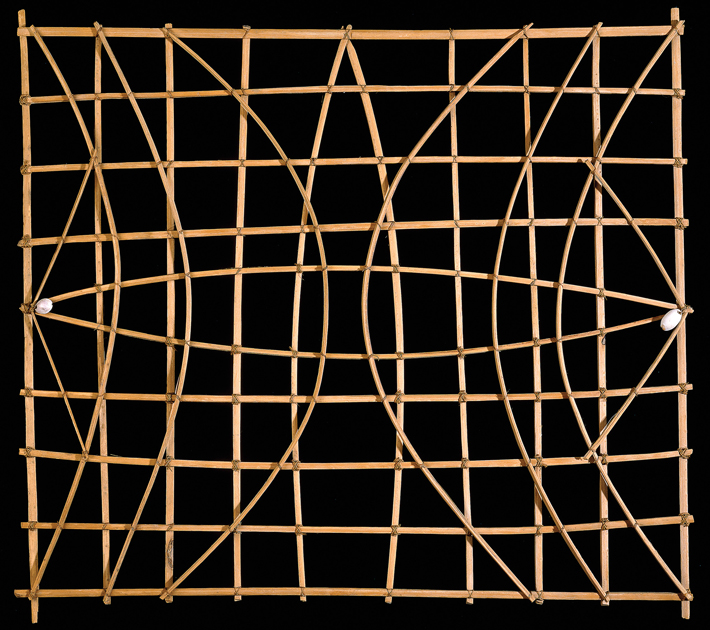MARSHALL ISLANDS STICK CHART

 MARSHALL ISLANDS STICK CHART. DATE: ca. late 19th to early 20th centuries. MATERIAL: Wood and cowrie shell. DIMENSIONS: 2 feet by 1.8 feet. FOUND: Marshall Islands, Micronesia.
MARSHALL ISLANDS STICK CHART. DATE: ca. late 19th to early 20th centuries. MATERIAL: Wood and cowrie shell. DIMENSIONS: 2 feet by 1.8 feet. FOUND: Marshall Islands, Micronesia.
(© The Trustees of the British Museum/Art Resource, NY)
The education of a navigator in the Marshall Islands, a Micronesian archipelago in the South Pacific, traditionally began by being blindfolded in a canoe. Young sailors learned to feel and intuit the motion of the sea before ever venturing out on ocean journeys. The deep Marshallese connection with waves and their movements reaches back more than 2,000 years to land-finding techniques used by the islands’ first settlers.
Scholars have identified two different types of Marshall Islands stick charts, wooden diagrams the Marshallese have been producing since at least the middle of the nineteenth century. The first and probably older type, shown here, contains abstract representations of how waves interact with bodies of land in general. The second type illustrates actual islands, often represented by cowrie shells, along with swell patterns identified and recorded by pilots. “There aren’t that many examples from across the Pacific of this kind of navigational knowledge being encoded or physically represented,” says anthropologist Joseph Genz of the University of Hawaii. He says the charts were used mainly as teaching devices rather than real-time way-finders. They help to impart perhaps the most crucial concept in the Marshallese navigational tradition, that of the dilep, or “backbone wave.” “People still describe the dilep as the most important wave to find,” Genz says. “It’s like a path you can follow to the next atoll. Instead of going landmark to landmark, you go seamark to seamark.”
News
The Hanging Temple: China’s 1,500-Year-Old Cliffside Marvel of Faith and Engineering
The Hanging Temple: China’s 1,500-Year-Old Cliffside Marvel of Faith and Engineering Perched precariously on the cliffs of Mount Heng in Shanxi Province, China, the Hanging Temple, also known as Xuankong Temple, Hengshan Hanging Temple, or Hanging Monastery, is an architectural…
The Willendorf Venus: A 30,000-Year-Old Masterpiece Reveals Astonishing Secrets
The Willendorf Venus: A 30,000-Year-Old Masterpiece Reveals Astonishing Secrets The “Willendorf Venus” stands as one of the most revered archaeological treasures from the Upper Paleolithic era. Discovered in 1908 by scientist Johann Veran near Willendorf, Austria, this small yet profound…
Unveiling the Maya: Hallucinogens and Rituals Beneath the Yucatán Ball Courts
Unveiling the Maya: Hallucinogens and Rituals Beneath the Yucatán Ball Courts New archaeological research has uncovered intriguing insights into the ritual practices of the ancient Maya civilization. The focus of this study is a ceremonial offering found beneath the sediment…
Uncovering the Oldest Agricultural Machine: The Threshing Sledge’s Neolithic Origins
Uncovering the Oldest Agricultural Machine: The Threshing Sledge’s Neolithic Origins The history of agricultural innovation is a fascinating journey that spans thousands of years, and one of the earliest known agricultural machines is the threshing sledge. Recently, a groundbreaking study…
Nara’s Ancient Sword: A 1,600-Year-Old Protector Against Evil Spirits
Nara’s Ancient Sword: A 1,600-Year-Old Protector Against Evil Spirits In a remarkable discovery that has captured the attention of archaeologists and historians alike, a 7.5-foot-long iron sword was unearthed from a 1,600-year-old burial mound in Nara, Japan. This oversized weapon,…
The Inflatable Plane, Dropped Behind the Lines for Downed Pilots
Experimental The Inflatable Plane, Dropped Behind the Lines for Downed Pilots The Inflatoplane from Goodyear was an unconventional aircraft developed by the Goodyear Aircraft Company, a branch of the renowned Goodyear Tire and Rubber Company, also famed for the Goodyear…
End of content
No more pages to load











